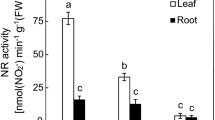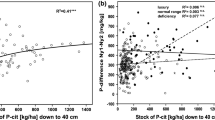Abstract
Nitrogen metabolism of the needles of 40-year-old Douglas fir and Scots pine trees, growing in two forest stands on cation-poor and acidic sandy soil with a relatively high atmospheric nitrogen deposition was studied. The composition of the free amino acid (FAA) pool, the concentrations of total nitrogen and soluble protein and the activities of glutamine synthetase (GS) and glutamate dehydrogenase (GDH) were determined in the needles. An excessive nitrogen supply by a high atmospheric nitrogen deposition in both forest stands was indicated by the high concentrations of total nitrogen and the amino acids arginine, glutamic acid, glutamine and aspartic acid in control trees. In addition the effect of optimal nutrition and water supply (fertigation) on the needle nitrogen metabolism was evaluated. The total concentration of the FAA pool in needles of both tree species was lower in the fertigated than in the non-fertigated (control) trees, except for 1-year-old needles of Scots pine, in which the concentration after fertigation did not differ from the control. The lower total FAA concentration in the fertigated trees could be attributed to arginine, the concentration of which was on average 60% lower than in the control. Neither the concentration of soluble protein nor the activity of GS were influenced by fertigation. The activity of GDH in fertigated trees only differed significantly from the control in October. Scots pine needles had higher concentrations of protein (50%) and higher activities of GS (44%) and GDH (25%) than Douglas fir needles. Possible explanations for the lower vitality of Douglas fir compared to Scots pine are given.
Similar content being viewed by others
References
Aronsson A (1985) Indications of stress at unbalanced nutrient contents of spruce and pine. J R Swedish Acad Agric For [Suppl] 17: 40–51
Bradford MM (1976) A rapid and sensitive method for the quantization of microgram quantities of protein utilizing the principle of protein-dye binding. Anal Biochem 72: 248–254
De Visser PHB (1990) Manipulation of the water and nutrient supply in two forest ecosystems in the Netherlands that are exposed to acid atmospheric deposition. In: Dutch Priority Programme on Acidification Report no 100.1, National Institute of Public Health and Environmental Protection (RIVM), Bilthoven, The Netherlands
De Visser PHB, Beier C, Rasmunssen L, Kreutzer K, Steinberg N, Bredemeier M, Blanck K, Farrell TP, Cummins T (1993) Biological response of forest ecosystems to input changes of water, nutrients and atmospheric loads. For Ecol Manage (in press)
Dueck TA, Dorél FG, Ter Horst R, Van der Eerden LJ (1991) Effects of ammonia, ammonium sulphate and sulphur dioxide on the frost sensitivity of Scots pine (Pinus sylvestris L.). Water Air Soil Pollut 54: 35–49
Duyzer JH, Verhagen HLM, Weststrate JH, Bosveld FC (1992) Measurement of the dry deposition flux of NH3, onto coniferous forest. Environ Pollut 75: 3–13
Erisman JW (1991) Acid deposition in The Netherlands. National Institute of Public Health and Environmental Protection (RIVM) Report no.723001002, Bilthoven, The Netherlands
Finlay RD, Ek H, Odham G, Söderström B (1989) Uptake, translocation and assimilation of nitrogen from 15N-labelled ammonium and nitrate sources by intact ectomycorrhizal systems of Fagus sylvatica infected with Paxillus involutus. New Phytol 113: 47–55
Flückiger W, Braun S (1992) Nitrogen deposition an its consequences for nutrient imbalances and hostplant-parasite relationships. Proceedings 15th International meeting of specialists in air pollution effects on forest ecosystems, IUFRO-Centennial, Tharandt/Dresden, Germany, 9–11 September 1992
Heij GT, Schneider T (eds) (1991) Acidification research in The Netherlands. Environmental Science Series no. 46. Elsevier, Amsterdam
Heinsdorf M (1991) Einfluß der Emission N-haltiger Abprodukte auf Ernährungszustand und Mykorrhizaentwicklung von benachbarten Kiefernstangenhölzern. Beitr Forstwirtschaft 25: 62–65
Ingestad T (1988) A fertilization model based on the concepts of nutrient flux density and nutrient productivity. Scan J For Res 3: 157–173
Kim YT, Glerum C (1988) Free amino acid concentrations in red pine needles during three successive autumns. Can J For Res 18: 1286–1290
Kim YT, Glerum C, Stodart J, Colombo SJ (1987) Effect of fertilization on free amino acid concentrations in black spruce and jack pine containerized seedlings. Can J For Res 17: 27–30
Lea PJ, Blackwell RD, Joy KW (1992) Ammonia assimilation in higher plants. In: Mengel K, Pilbeam DJ (eds) Nitrogen metabolism of plants. Clarendon Press, Oxford, pp 153–186
MacKenzie SL (1987) The heptafluorobutyril iso-butyl ester derivatives of amino acids: derivatisation, separation and applications. Amino acid analysis by gas chromatography 1: 93–117
MacKenzie SL, Holme KR (1984) Analyses of conifer leaf free amino acids by gas-liquid chromatography. J Chromatogr 299: 387–396
Manderscheid R, Jäger HJ (1993) Seasonal changes in nitrogen metabolism of spruce needles [Picea abies (L.) Karst.] as affected by water stress and ambient air pollutants. J Plant Physiol 141: 494–501
Margolis HA, Vézina LP, Ouimet R (1988) Relation of light and nitrogen source to growth, nitrate reductase and glutamine synthetase activity of jack pine seedlings. Physiol Plant 72: 790–795
Müller-Starck G, Ziehe M (1992) Genetic selection under field stress conditions in Fagus sylvatica L. Proceedings 15th International meeting of specialists in air pollution effects on forest ecosystems. IUFRO-Centennial, Tharandt/Dresden, Germany, 9–11 September 1992
Näsholm T, Ericsson A (1990) Seasonal changes in amino acids, protein and total nitrogen in needles of fertilized Scots pine trees. Tree Physiol 6: 267–281
Nihlgård B (1985) The ammonium hypothesis — an additional explanation to the forest dieback in Europe. Ambio 14: 2–8
Oaks A (1986) Biochemical aspects of nitrogen metabolism in a whole plant context. In: Lambers H, Neeteson JJ, Stulen I (eds) Fundamental, ecological and agricultural aspects of nitrogen metabolism in higher plants. Martinus Nijhoff, Dordrecht, The Netherlands, pp 133–151
O'Neal D, Joy KW (1973) Glutamine synthetase of pea leaves. I. Purification, stabilization and pH optima. Arch Biochem Biophys 159: 113–122
Pahlich E, Joy KW (1971) Glutamate dehydrogenase from pea roots: purification and properties of the enzyme. Can J Biochem 49: 127–138
Pérez-Soba M, Stulen I, Van der Eerden LJM (1994) Effect of atmospheric ammonia on the nitrogen metabolism of Scots pine (Pinus sylvestris) needles. Physiol Plant (in press)
Pietilä M, Kuusipuro P, Pietiläinen P, Lähdesmäki P (1989) Specificity and seasonal variation of arginase, glutamate synthase and nitrate reductase activities in Scots pine needles. Plant Sci 64: 153–160
Pietilä M, Lähdesmäki P, Pietiläinen P, Ferm A, Hytönen J, Pätilä A (1991) High nitrogen deposition causes changes in amino acid concentrations and protein spectra in needles of the Scots pine (Pinus sylvestris). Environ Pollut 72: 103–115
Rabe E, Lovatt CJ (1986) Increased arginine biosyntheses during phosphorus deficiency. Plant Physiol 81: 774–779
Robinson SA, Slade AP, Fox GG, Phillips R, Ratcliffe RG, Stewart GR (1991) The role of glutamate dehydrogenase in plant nitrogen metabolism. Plant Physiol 95: 509–516
Smits TFC (1992) The vitality of the Dutch forest 10. Report of the national inventory (in Dutch) Ministerie van Landbouw, Natuurbeheer en Visserij, The Hague, The Netherlands, pp 1–17
Stolen I (1986) Interactions between nitrogen and carbon metabolism in a whole plant context. In: Lambers H, Neeteson JJ, Stulen I (eds) Fundamental, ecological and agricultural aspects of nitrogen metabolism in higher plants. Martinus Nijhoff, Dordrecht, The Netherlands, pp 261–278
Ten Klooster D (1993) The effect of irrigation and fertigation on the water and nutrient supply of Douglas fir. M. Sc. thesis, Department of Soil Science and Plant Nutrition, Agricultural University of Wageningen, The Netherlands
Termorshuizen AJ (1993) The influence of nitrogen fertilisers on ectomycorrhizas and their fungal carpophores in young stands of Pinus sylvestris. For Ecol Manage 57: 179–189
Van Breemen N, Van Dijk HFG (1988) Ecosystem effects of atmospheric deposition of nitrogen in The Netherlands. Environ Pollut 54: 249–274
Vance N, Zaerr JB (1990) Analyses by high-performance liquid chromatography of free amino acids extracted from needles of drought-stressed and shaded Pinus ponderosa seedlings. Physiol Plant 79: 23–30
Van der Eerden LJM, Dueck TA, Berdowski JJM, Greven H, Van Dobben HF (1991) Influence of NH3 and (NH4)2SO4 on heathland vegetation. Acta Bot Neerl 40: 281–296
Van der Eerden LJM, Pérez-Soba M (1992) Physiological responses of Pinus sylvestris to atmospheric ammonia. Trees 6: 48–53
Van Dijk HFG, Roelofs JGM (1988) Effects of excesive ammonium deposition on the nutritional status and condition of pine needles. Physiol Plant 73: 494–501
Van Dijk HFG, De Louw MHJ, Roelofs JGM, Verburgh JJ (1990) Impact of artificial, ammonium-enriched rainwater on soils and young coniferous trees in a greenhouse. II. Effects on the trees. Environ Pollut 63: 41–59
Van Dijk HFG, Van der Graag M, Perik PJM, Roelofs JGM (1992) Nutrient availability in Corsican pine stands in The Netherlands and the occurrence of Sphaeropsis sapinea: a field study. Can J Bot 70: 870–875
Van Hove LWA, Van Kooten O, Van Wijk KJ, Vredenberg WJ, Adema EH, Pieters GA (1991) Physiological effects of long term exposure to low concentrations of SO2 and NH3 on poplar leaves. Physiol Plant 82: 32–40
Van Hove LWA, Bossen ME, Mensink MGJ, Van Kooten O (1992) Physiological effects of a long term exposure to low concentrations of NH3, NO2 and SO2 on Douglas fir (Pseudotsuga menziesii). Physiol Plant 86: 559–567
Von Heinsdorf D, Krauss HIH (1991) Massentierhaltung und Waldschäden auf dem Gebiet der ehemaligen DDR. Forst Holz 46: 356–361
Waring RH (1991) Responses of evergreen trees to multiple stresses. In: Mooney HA, Winner WE, Pell EJ (eds) Response of plants to multiple stress. Academic Press, London, pp 371–390
Author information
Authors and Affiliations
Rights and permissions
About this article
Cite this article
Pérez-Soba, M., de Visser, P.H.B. Nitrogen metabolism of Douglas fir and Scots pine as affected by optimal nutrition and water supply under conditions of relatively high atmospheric nitrogen deposition. Trees 9, 19–25 (1994). https://doi.org/10.1007/BF00197865
Received:
Accepted:
Issue Date:
DOI: https://doi.org/10.1007/BF00197865




